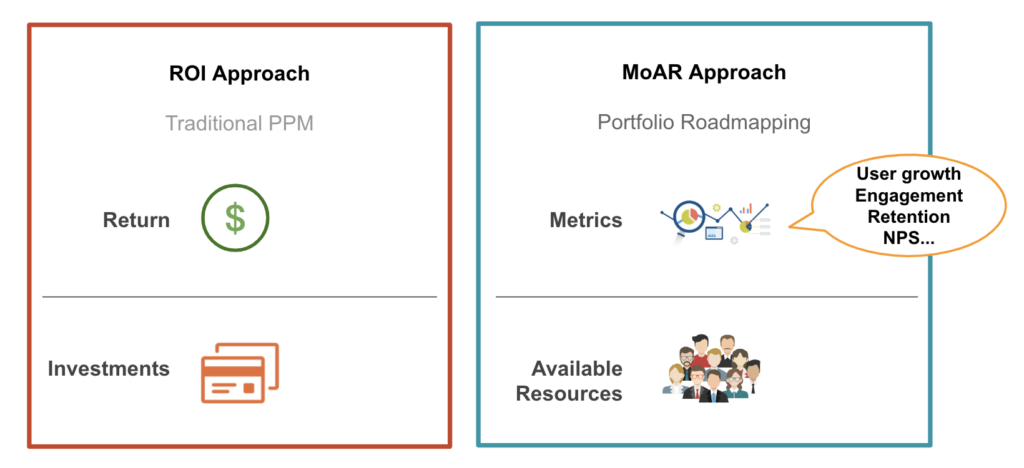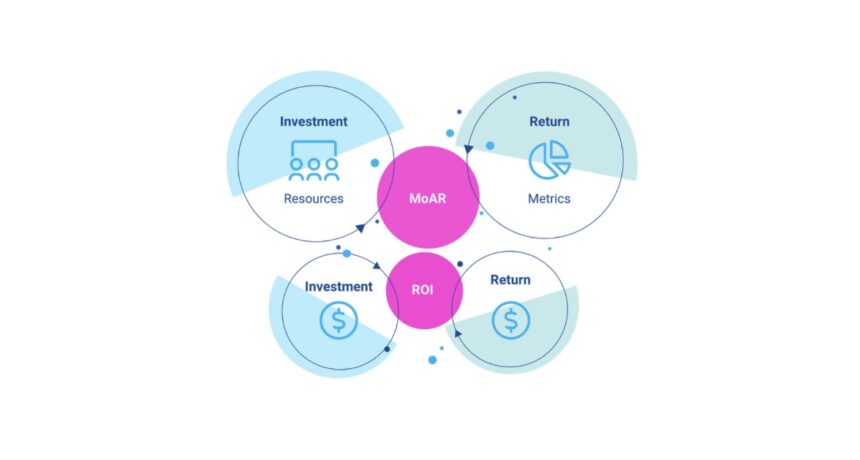Nearly every department has a KPI to measure short-term success. But what about your product team? What one metric measures product’s effectiveness and impact? Return on Investment (ROI) measures monetary value, but there is more to effective product portfolio management than ROI. So, instead, we recommend using Metrics Over Available Resources (MoAR) to directly evaluate opportunities to maximize your product investment and business outcomes.
The Shift From ROI
Portfolio Management is a finance concept that refers to allocating investments across different asset classes (based on the assumed risk and reward) to optimize the overall outcome. Product Portfolio Management (PPM) applies that same approach to your organization, allocating scarce resources to the work that yields the most value.
Years ago, I led strategic planning for PayPal’s product portfolios. We needed to evaluate opportunities that could help the company achieve specific objectives, such as improving engagement, launching into a new market, reducing transaction costs, and taking risks on emerging trends.
How could we compare these diverse product initiatives across revenue growth, cost reduction, and risky innovation?
We tried using ROI but quickly ran into limitations. It was nearly impossible to clearly and consistently tie initiatives to specific outcomes. We needed a solution to measure and evaluate opportunities more directly than ROI. That led us to develop a new approach – MoAR, or Metrics Over Available Resources.
The Trouble With ROI
Return on Investment (ROI) is a ratio between net profit (over a period) and the investment cost. It is a performance measure often used to evaluate or compare the efficiency of different investments.
ROI works well in traditional industries or functions where benefits and scarce resources can easily be measured in money. But ROI becomes elusive when you need to measure outcomes that are not clearly associated with money or have other forms of scarce resources.

Product Portfolio Metrics: Measuring Benefits
In the world of manufactured goods, measuring a product’s financial impact is relatively straightforward. For instance, we can easily track how much revenue a newly designed cup generates in 1 year and compare that to the costs to calculate its 1-year ROI.
In contrast, a software product consists of many features. We can infer the monetary benefit of a proposed new feature by estimating its relative contribution to a business metric. But it is nearly impossible to directly measure and attribute the financial outcome of individual product features.
An Example
Imagine that you are a SaaS provider. Based on experience, you know that increasing sign-up conversions by 5% will result in $100k in quarterly profit if everything else remains unchanged. Feature A aims to increase sign-ups by 2%, so we can infer that launching this feature will result in a $40k bump in profit.
However, although we can measure the change in profit, we cannot attribute the change to a given feature unless we do nothing else to affect sign-up conversions during that time. That isn’t a reasonable expectation for an agile company.
Other complicating factors include the following:
- Monetary-based benefit measures have a negative bias against innovation and risk-taking. Investing in a cash-cow mature business always generates a higher ROI than developing products, at least initially.
- Money isn’t the only scarce resource. Sometimes the most limited resource is human capital. If you need software engineers with highly specialized (and in-demand) skills to build the product and achieve your growth metrics, you must factor that into your thought process
So, What are Metrics Over Available Resources (MoAR)?
Metrics Over Available Resources (“MoAR”) is the ratio of the expected contribution of a product feature towards a measurable business outcome over the number of resources needed to achieve that contribution.
MoAR provides a more direct and holistic measure for portfolio planning and a clearer visual of product portfolio metrics than ROI. Let’s look at MoAR in action to show you what I mean.
Using MoAR for Product Planning
To use MoAR, start with defining the appropriate metrics to measure benefits towards the desired business outcomes or objectives.
- Metrics such as user growth, referral rate, retention, and Net Promoter Score (NPS), are the direct measure of product benefits. And they are often leading indicators of monetary-based returns. Furthermore, companies that adopt an OKR or V2MOM framework can easily connect outcome targets with product portfolio roadmapping. MoAR enables an outcome-driven portfolio roadmap.
- Available Resources indicate scarce resources, like Scala Engineers or the UX designer who designed your last app.
During portfolio roadmap planning, compare features that require the same resources using MoAR to prioritize. Then add up the contribution of all planned features toward the goal. The total contribution should be 100% or higher to ensure the goal is achievable based on the current plan. Anything less indicates an outcome or resource gap.
For example, assume a key business goal for the next quarter is to increase conversion by 10%. Three features are coming to the team, and only 16 weeks of front-end resources are available.
- Feature A is expected to contribute 40% of this goal and requires eight weeks of front-end resources. The MoAR for Feature A is 40/8 = 5.
- Feature B may add 20% of this goal and requires eight weeks of front-end resources. The MoAR for Feature B is 20/8 = 2.5.
- Feature C contributes to a cost-saving metric but not towards the conversion goal. And it requires four weeks of front-end resources. Thus, the MoAR for Feature C is 0.
Using MoAR to Prioritize Conversion-Boosting Features
| Feature A | Feature B | Feature C | Total | |
| Contribution (%) | 40 | 20 | 0 | 60 |
| Resource needed (in weeks) | 8 | 8 | 4 | 20 |
| MoAR | 5 | 2.5 | 0 | / |
Let’s evaluate these features.
First, the total resource requirement is 20 weeks. We only have 16 weeks available, so we have a shortage of front-end resources to support these three features. We will de-prioritize Feature C as its MoAR is 0.
However, this plan is not ready to go yet because there is an outcome gap – Features A and B will contribute to only 60% of the target metric, so we will not achieve the desired outcome.
The team needs to either reduce the target outcome by 40% and get stakeholder buy-in or start over to design a different feature set to achieve 100% of the target.
Although this is not what the team hoped to see, the information is vital. Identifying gaps during the planning phase gives the team time to address them before it’s too late.
Metrics Over Available Resources: Key Takeaways
The Metrics over Available Resources (“MoAR”) prioritization method allows companies to readily incorporate a direct measure against goals into their roadmap planning and dynamic alignment process. That enables better product decisions, easily visualized product portfolio metrics, and improved overall outcomes.
MoAR is a key element of Responsive PPM – the new portfolio management approach for outcome-driven organizations. Book a demo today to see MoAR in action.




